New Developments and Progress in Absorption Chillers for Solar Cooling Applications
Abstract
:1. Introduction
2. Solar-Powered Absorption Cooling Systems
2.1. System Description
2.2. Conventional Absorption Chillers—Technical Challenges
- Heat rejection. High ambient temperature has two adverse effects: (1) an increased cooling load of the building and (2) a lower potential for heat rejection of the cooling tower. An air-cooled heat rejection system involves increasing the absorber and condenser temperatures which creates the need for high-temperature driving heat in the absorption chillers. In water/LiBr absorption chillers, crystallization is the main obstacle to operating the chiller at high ambient temperature, so various methods have been proposed and applied to limit the risk. These methods include the use of chemical inhibitors, heat and mass transfer enhancement in the absorber, and boosting the absorber pressure using mechanical compression. Consequently, the absorption chillers’ potential to reject heat to the atmosphere is hampered, particularly in hot climates. Thereby, evaporative or wet cooling towers are commonly required which is a shortcoming in regions with a scarcity of water. Even in regions where water is not a limited resource, the costs of water and bacteria treatment in evaporative cooling towers of small capacity systems can be as high as 30–40% of the operating costs. Therefore, the absorption systems currently available are relatively expensive in terms of capital expenditure (CAPEX) and operating expenses (OPEX).
- Compactness. The cost of the heat exchangers is the biggest contribution to the capital investment of any chiller technology. In this regard, absorption chillers always have a downside compared to compression chiller technologies, since they have more heat and mass exchanger components. So, among other factors, such as reducing the consumption of parasitic electricity, if absorption chillers are to be economically competitive, heat exchangers need to be smaller. Conventional absorption chillers are unnecessarily large because of dead spaces that do not have any function (i.e., which are not involved in the cooling process [13,14,15]). Moreover, since absorption chillers are large, it is usually impossible or very difficult to retrofit them in existing buildings. Therefore, there is a significant economic incentive to minimize the overall size of the chiller in any new developments.
- Capacity. The capacity of most commercial absorption chillers is 300 kW or more. In terms of capacity, shell and tube heat exchangers are state-of-the-art technologies; in these chillers, copper tubes are rolled into the heavy front plates to ensure vacuum operating conditions inside the water/LiBr absorption chiller. Using this practice in small-scale chillers (<200 kW) leads to a high specific cost [13]. On the other hand, small chiller machines based on coiled tube heat exchangers are available from some manufacturers, but they have high-pressure drops which lead to high parasitic electricity demands (i.e., they limit the advantages of heat-driven chillers) [13].
- Temperature glide of the driving heat. A conventional single-effect water/LiBr absorption chiller typically uses 85–90 °C hot water as its driving heat and releases it at about 75–80 °C (i.e., a temperature glide of up to 10 K) [16]. For example, in several chillers driven by district heat, the driving heat transfer medium only cools by around 10 °C. This means that a large proportion of the useable heat at a relatively high temperature is recirculated unnecessarily to the driving heat source (e.g., district heat network or solar thermal collector installation). It also requires high pump capacity and electricity consumption.
2.3. Primary Energy Use
3. Newly Developed Commercial Absorption Chillers
3.1. Air-Cooled Small Capacity Chiller
3.2. Efficient and Compact Absorption Heat Pump: Cooling and Heating
3.3. Compact Absorption Chiller: Asymmetric Plate Heat Exchanger
3.4. Single-Effect Double-Lift (Half-Effect) Absorption Chiller
3.5. Single/Double-Effect Absorption Chiller: Solar-Gas Fired
4. Prototypes of Absorption Chillers
4.1. Single-Stage Absorption Chillers
4.1.1. Ammonia-Based Working Pairs
4.1.2. Water/LiBr Working Pair
4.2. Advanced Absorption Chillers
4.2.1. Double-Lift Absorption Chillers
4.2.2. Mechanical Compressor Assisted Absorption Chillers
5. Research Trends and Opportunities
- Compactness: the absorber and desorber of market available chillers are mostly based on falling film configurations in which the horizontal and vertical tube falling film exchangers are the components that have most been implemented and studied [88]. Nevertheless, this type of design has downsides, including maldistribution of the film on the exchanger surface, which disturbs flow uniformity at low Reynolds number [89] and results in dry patches on the plate surface (non-wetted areas) and thick liquid films (wetted areas). Therefore, it reduces the absorption and desorption rates, and decreases the useful absorber and desorber surfaces, which results in bulky components. This is especially crucial for the absorber since it is the least efficient component of the chiller because of the low mass diffusion coefficient of water vapor in the solution of water/LiBr [90]. Additionally, heat transfer from wetted areas is also lower than from perfectly wetted surfaces because of the greater thickness of the film. Therefore, recently, the use of (i) plate-type falling film absorbers [88] and (ii) membrane contactors in the absorber and desorber have been proposed and investigated for the development of compact and inexpensive water/LiBr [91,92,93,94,95,96,97] and ammonia/water [98,99] absorption refrigeration systems, particularly in a small capacity range. The use of a plate-type falling film configuration in the absorber and desorber of the absorption chiller can significantly enhance the absorption and desorption rates, which can make these devices much more compact and more efficient for water/LiBr-based mixtures.
- Control strategy and operation: It is common practice in the control and operation of absorption chillers to use fixed volume flow rates for external heat carrier fluids (i.e., driving heat, heat rejection, and chilled water streams). These volume flow rates and the fan speed of the heat rejection unit are fixed at the values for the nominal design condition (i.e., nominal thermal powers). This operation strategy leads to parasitic electricity consumption dominating the chiller’s part-load operation. Consequently, the benefit of low electrical energy consumption for absorption chillers is reduced, which leads to low electrical efficiency (i.e., low electrical COP). Moreover, theoretically, reducing the pump/fan volume flow rate by decreasing the pump/fan speed about 50% reduces electricity consumption by 87% [100]. Therefore, new control and operation strategies can be implemented by actively controlling external volume flow rates via variable speed pumps and fans. By so doing, the whole system consumes less electricity and electrical COPs are higher. This new type of control strategy has already been applied in field tests with newly developed absorption chillers, new-AHP, in solar and tri-generation (CHP plants) applications [24,100]. Because of the intermittent nature of the solar resource and the variation in the cooling load during the day (and also the year), these newly developed absorption chillers need to be controlled if they are to perform optimally and operate safely. Hence, in recent years, control strategies have been developed on the basis of chiller performances in field tests and simplified models (such as the characteristic equation method) to describe the full and partial load operation of the chillers.
6. Concluding Remarks
Author Contributions
Funding
Acknowledgments
Conflicts of Interest
Nomenclature
| AABS | auxiliary absorber |
| ABS | absorber |
| ABS-HX | absorber heat exchanger |
| ADES | auxiliary desorber |
| AHP | absorption heat pump |
| ASC | air-cooled small capacity water/LiBr chiller |
| ASHX | auxiliary solution heat exchanger |
| BF | base frame |
| CP | circulation pump |
| COM | compressor |
| CON | condenser |
| DES | desorber |
| DH | district heating |
| EVA | evaporator |
| HABS | high-temperature absorber |
| HDES | high-temperature desorber |
| HSHX | high-temperature solution heat exchanger |
| HX | heat exchanger |
| LABS | low-temperature absorber |
| LCON | low-temperature condenser |
| LDES | low-temperature desorber |
| LSHX | low-temperature solution heat exchanger |
| PHE | plate heat exchanger |
| RAC | refrigerant accumulator |
| REV | refrigerant expansion valve |
| SAC | solution accumulator |
| SCON | single-effect condenser |
| SDES | single-effect desorber |
| SEV | solution expansion valve |
| SHX | solution heat exchanger |
| SP | solution pump |
| Variables | |
| COP | coefficient of performance (-) |
| PE | primary energy flow (kW) |
| PER | primary energy rate (-) |
| thermal power (kW) | |
| SF | solar fraction (-) |
| electrical power (kW) | |
| Subscripts | |
| abs | absorber (or absorption chiller) |
| b | backup |
| com | vapor-compression chiller |
| con | condenser |
| des | desorber |
| dhs | driving heat source |
| el | electrical |
| eva | evaporator |
| habs | high-temperature absorber |
| hdes | high-temperature desorber |
| labs | low-temperature absorber |
| ldes | low-temperature desorber |
| sol | solar |
| th | thermal |
References
- OECD/IEA. The Future of Cooling. Opportunities for Energy-Efficient Air Conditioning; OECD/IEA: Paris, France, 2018. [Google Scholar] [CrossRef]
- OECD/IEA. News. Air Conditioning Use Emerges as One of the Key Drivers of Global Electricity-Demand Growth, IEA Publ. 2018. Available online: https://www.iea.org/news/air-conditioning-use-emerges-as-one-of-the-key-drivers-of-global-electricity-demand-growth (accessed on 25 April 2020).
- Weiss, W.; Spö;rk-Dür, M. Solar heat worldwide 2019 Edition: Global Market Development and Trends in 2018. In Detailed Market Figures 2017; IEA Solar Heating & Cooling Programme: Graz, Austria, 2019. [Google Scholar]
- International Energy Agency (IEA). Annual Report 2018 Solar Heating and Cooling Programme; International Energy Agency: Paris, France, 2019. [Google Scholar]
- Ullah, K.; Saidur, R.; Ping, H.; Akikur, R.; Shuvo, N. A review of solar thermal refrigeration and cooling methods. Renew. Sustain. Energy Rev. 2013, 24, 499–513. [Google Scholar] [CrossRef]
- Al-Alili, A.; Hwang, Y.; Radermacher, R. Review of solar thermal air conditioning technologies. Int. J. Refrig. 2014, 39, 4–22. [Google Scholar] [CrossRef]
- Ferreira, C.A.I.; Kim, D.-S. Techno-economic review of solar cooling technologies based on location-specific data. Int. J. Refrig. 2014, 39, 23–37. [Google Scholar] [CrossRef]
- Aliane, A.; Abboudi, S.; Seladji, C.; Guendouz, B. An illustrated review on solar absorption cooling experimental studies. Renew. Sustain. Energy Rev. 2016, 65, 443–458. [Google Scholar] [CrossRef]
- Sheikhani, H.; Barzegarian, R.; Heydari, A.; Kianifar, A.; Kasaeian, A.; Gróf, G.; Mahian, O. A review of solar absorption cooling systems combined with various auxiliary energy devices. J. Therm. Anal. Calorim. 2018, 134, 2197–2212. [Google Scholar] [CrossRef]
- Shirazi, A.; Taylor, R.A.; Morrison, G.L.; White, S.D. Solar-powered absorption chillers: A comprehensive and critical review. Energy Convers. Manag. 2018, 171, 59–81. [Google Scholar] [CrossRef]
- Prieto, A.; Knaack, U.; Auer, T.; Klein, T. COOLFACADE: State-of-the-art review and evaluation of solar cooling technologies on their potential for façade integration. Renew. Sustain. Energy Rev. 2019, 101, 395–414. [Google Scholar] [CrossRef]
- Herold, K.E.; Radermacher, R.; Klein, S.A. Absorption Chillers and Heat Pumps, 2nd ed.; CRC Press Inc.: Boca Raton, FL, USA, 2016. [Google Scholar]
- Petersen, S.; Hansske, A.; Hennrich, C.; Stangl, J.; Mittermaier, M.; Helm, M.; Zachmeier, P.; Natzer, S.; Lanser, W.; Ziegler, F. Development of a 50 kW Absorption Chiller; Int. Congr. Refrig.: Prague, Czech Republic, 2011; p. 8. [Google Scholar]
- Petersen, S.; Beil, A.; Hennrich, C.; Lanser, W.; Hüls, W.G. New Absorption Chillers for CHCP or Solar Cooling System Technology; Kühn, A., Ed.; Therm. Driven Heat Pumps Heat. Cool.: Berlin, Germany, 2013; p. 9. Available online: http://nbn-resolving.de/urn:nbn:de:kobv:83-opus4-39458 (accessed on 16 April 2020).
- BINE Information Service, Bee and Bumblebee Begin Field Tests. PDF. Available online: http://www.bine.info/en/topics/industrial-and-commercial/news/biene-und-hummel-gehen-in-den-feldtest.pdf (accessed on 10 April 2020).
- Fujiia, T.; Takeda, N.; Miyauchi, H.; Kawamura, M.; Uchida, M. Cycle simulation and prototyping of single-effect double-lift absorption chiller. In Proceedings of the 12th IEA Heat Pump Conference, Rotterdam, The Netherlands, 15–18 May 2017; pp. 1–10. [Google Scholar]
- Albers, J.; Kühn, A.; Petersen, S.; Ziegler, F. Development and Progress in Solar Cooling Technologies with Sorption Systems. Chem. Ing. Tech. 2011, 83, 1853–1863. [Google Scholar] [CrossRef]
- Ziegler, F. Sorption heat pumping technologies: Comparisons and challenges. Int. J. Refrig. 2009, 32, 566–576. [Google Scholar] [CrossRef]
- Munkoe, L. Solar Cooling Unit. WIPO|PCT Patent WO 2014/174409 A2, 30 October 2014. [Google Scholar]
- PURIX. Solar Cooling System: Product Catalogue A25s. 2015. Available online: http://www.purix.com/wp-content/uploads/2017/10/PURIX-Catalogue-A25s-EN.pdf (accessed on 10 March 2020).
- State of Green, Solar Cooling System. 2020. Available online: https://stateofgreen.com/en/partners/purix/solutions/solar-heat-pump/ (accessed on 24 March 2020).
- PURIX. Case study|PURIX: Cut Electricity Demand with a Green Air Conditioning System. 2015. Available online: http://www.purix.com/wp-content/uploads/2017/11/Danfoss-PURIX-case-EN.pdf (accessed on 10 March 2020).
- PURIX ApS. Available online: https://www.purix.com/ (accessed on 25 March 2020).
- Güido, W.H.; Lanser, W.; Petersen, S.; Ziegler, F. Performance of absorption chillers in field tests. Appl. Therm. Eng. 2018, 134, 353–359. [Google Scholar] [CrossRef]
- Paitazoglou, C. Solar Cooling with Highly Efficient Absorption Chillers [Presentation]. 2015, p. 35. Available online: http://www.renewables-made-in-germany.com (accessed on 11 February 2020).
- W. Baelz & Sohn GmbH & Co. Model “Bee” 50 kW. 2020. Available online: https://www.baelz.de/en/theme-vorlagenseiten/bee/ (accessed on 25 April 2020).
- W. Baelz & Sohn GmbH & Co. Typ Hummel 160 kW. 2020. Available online: https://www.baelz.de/en/systems/kaelte/hummel/ (accessed on 12 April 2020). (In German).
- W. Baelz & Sohn GmbH & Co. Typ Hornisse 500 kW. 2020. Available online: https://www.baelz.de/en/systems/kaelte/hornisse/ (accessed on 24 April 2020). (In German).
- Paitazogou, C.; Petersen, S.; Ziegler, F. Energy efficient cooling with new absorption chiller technology in solar cooling systems and CHPC-plants [Presentation]. In Proceedings of the EinB2017—6th Int. Conference “ENERGY Build. 2017” Energy, Athens, Greece, 21 October 2017; p. 26. [Google Scholar]
- Richter, L.; Heinrich, C.; Kemmerzehl, C.; Safarik, M.; Otto, M.; Weidner, G.; Burandt, B.; Herzog, R. Development of Water—Lithium Bromide Absorption Chillers Based on Asymmetric Plate Heat Exchangers. In Proceedings of the 25th IIR Int. Congr. Refrig., International Institute of Refrigeration, Montréal, QC, Canada, 24–30 August 2019; pp. 4550–4558. [Google Scholar] [CrossRef]
- Safarik, M.; Kemmerzehl, C. WEGRACAL C—New Water/LiBr Absorption Chillers Based on Plate Heat Exchangers [EAW and ILK Dresden Presentation]. 2018. Available online: https://www.iea-shc.org/Data/Sites/53/media/events/meeting-09/workshop/15-safarik_wegracal-c-new-water-libr-absorption-chillers-based-on-plate-heat-exchangers.pdf (accessed on 14 February 2020).
- EAW. Energieanlagenbau GmbH, ABSORPTIONSKÄLTEANLAGE WEGRACAL Maral. 2020. Available online: https://www.eaw-energieanlagenbau.de/absorber-akm.html (accessed on 14 April 2020). (In German).
- Schweigler, C.; Riesch, P.; Demmel, S.; Alefeld, G. A New Absorption Chiller to Establish Combined Cold, Heat, and Power Generation Utilizing Low-Temperature Heat; Winter Meet. Am. Soc. Heating, Refrig. Air Cond. Eng. Inc.: Atlanta, GA, USA, 1996. [Google Scholar]
- Schweigler, C.; Preissner, M.; Demmel, S.; Hellmann, H.; Ziegler, F. Operation and Performance of a 350 kW (100 RT) Single-Effect/Double-Lift Absorption Chiller in a District Heating Network. In Proceedings of the 1998 ASHRAE winter meeting, San Francisco, CA, USA, 17–21 January 1998. [Google Scholar]
- Hitachi Johnson Controls Air Conditioning Co., Ltd. Development of an Absorption Chiller Capable of Recovering Heat from Industrial Waste Heat in the Low Temperature Range with a Temperature Difference of Approximately Twice. 2017. Available online: https://www.jci-hitachi.com/jp/news/413.html (accessed on 3 April 2020). (In Japanese).
- World Energy, Co. 2AB—Single Effect Double Lift Hot Water Driven Absorption Chiller for District Heating & Industrial Use. 2018. Available online: http://worldenergy.co.kr/en/portfolio-item/2ab-2/ (accessed on 3 April 2020).
- Yabase, H.; Hirai, A. Solar Cooling System Using Solar-Driven Hybrid Chiller. In Proceedings of the International Refrigeration and Air Conditioning Conference, Purdue, IN, USA, 16–19 July 2012; pp. 1–9. [Google Scholar]
- Yabase, H. Technology and Application of Absorption Chillers by Kawasaki Thermal Engineering Co., Ltd. [Presentation]; Atmos. Technol. Summit United Nations Ind. Dev. Organ.: Vienna, Austria, 2013; pp. 1–28. [Google Scholar]
- Lubis, A.; Jeong, J.; Saito, K.; Giannetti, N.; Yabase, H.; Alhamid, M.I. Nasruddin Solar-assisted single-double-effect absorption chiller for use in Asian tropical climates. Renew. Energy 2016, 99, 825–835. [Google Scholar] [CrossRef]
- Lubis, A. Optimal Operation of Solar Energy Driven Single-Double-Effect Absorption Chiller. Ph.D. Thesis, Waseda University, Tokyo, Japan, 2019. [Google Scholar]
- Lubis, A.; Jeong, J.; Giannetti, N.; Yamaguchi, S.; Saito, K.; Yabase, H.; Alhamid, M.I. Nasruddin Operation performance enhancement of single-double-effect absorption chiller. Appl. Energy 2018, 219, 299–311. [Google Scholar] [CrossRef]
- Thermax Ltd, Multi-Energy Driven Chiller (2D Series). 2020. Available online: https://www.thermaxglobal.com/absorption-cooling/vapour-absorption-chillers/multi-energy-driven-chiller-2d-series/ (accessed on 26 March 2020).
- Kawasaki Thermal Engineering Co., Ltd. Absorption Chillers. Available online: http://www.khi.co.jp/corp/kte/EN/?_ga=2.237153856.1583288113.1591880702-1974263298.1587212439 (accessed on 24 April 2020).
- Mugnier, D.; Mopty, A.; Rennhofer, M.; Selke, T. IEA SHC TASK 53: State of the Art of New Generation Commercially Available Products; IEA Solar Heating and Cooling Programme: Perpignan, France, 2017. [Google Scholar]
- World Energy Co., Ltd. Absorption Chiller Heat Pump (Cataloge). Available online: http://worldenergy.co.kr/wp-content/uploads/2019/12/Catalogue_EN.pdf. (accessed on 24 April 2020).
- BINE Information Service. Cooling with Heat. A new Generation of Compact Chillers Cools and Heats with Low-Temperature Heat, Bonn, 07 2012. PDF. Available online: http://www.bine.info/fileadmin/content/Presse/Projektinfos_2012/Projekt_07-2012/ProjektInfo_0712_engl_internetx.pdf (accessed on 26 March 2020).
- W. Baelz & Sohn GmbH & Co. Save Energy? Baelz Has the Solution. 2020. Available online: https://www.baelz.de/index.php?eID=dumpFile&t=f&f=1431&token=6ac9f7e3822ebe362a8b88254c6ee8ec7ab39f31&download=&eht=1 (accessed on 25 April 2020).
- Zamora, M.; Bourouis, M.; Coronas, A.; Vallès, M. Part-load characteristics of a new ammonia/lithium nitrate absorption chiller. Int. J. Refrig. 2015, 56, 43–51. [Google Scholar] [CrossRef]
- Jiménez-García, J.C.; Rivera, W. Parametric analysis on the experimental performance of an ammonia/water absorption cooling system built with plate heat exchangers. Appl. Therm. Eng. 2019, 148, 87–95. [Google Scholar] [CrossRef]
- Boudéhenn, F.; Demasles, H.; Wyttenbach, J.; Jobard, X.; Chèze, D.; Papillon, P. Development of a 5 kW cooling capacity ammonia-water absorption chiller for solar cooling applications. Energy Procedia 2012, 30, 35–43. [Google Scholar] [CrossRef] [Green Version]
- Zamora, M. Industrial Optimization and Control Strategy of an Air-Cooled Ammonia/lithium Nitrate Absorption Chiller. Ph.D. Thesis, Universitat Rovira i Virgili, Tarragona, Spain, 2012. (In Spanish). [Google Scholar]
- Libotean, S.; Salavera, D.; Vallès, M.; Esteve, X.; Coronas, A. Vapor-liquid equilibrium of ammonia + lithium nitrate + water and ammonia + lithium nitrate solutions from (293.15 to 353.15) K. J. Chem. Eng. Data 2007, 52, 1050–1055. [Google Scholar] [CrossRef]
- Libotean, S.; Martín, A.; Salavera, D.; Vallès, M.; Esteve, X.; Coronas, A. Densities, viscosities, and heat capacities of ammonia + lithium nitrate and ammonia + lithium nitrate + water solutions between (293.15 and 353.15) K. J. Chem. Eng. Data 2008, 53, 2383–2388. [Google Scholar] [CrossRef]
- Ferreira, C.A.I. Thermodynamic and physical property data equations for ammonia-lithium nitrate and ammonia-sodium thiocyanate solutions. Sol. Energy 1984, 32, 231–236. [Google Scholar] [CrossRef]
- Cuenca, Y.; Salavera, D.; Vernet, A.; Teja, A.S.; Vallès, M. Thermal conductivity of ammonia + lithium nitrate and ammonia + lithium nitrate + water solutions over a wide range of concentrations and temperatures. Int. J. Refrig. 2014, 38, 333–340. [Google Scholar] [CrossRef]
- Farshi, L.G.; Ferreira, C.A.I.; Mahmoudi, S.; Rosen, M.A. First and second law analysis of ammonia/salt absorption refrigeration systems. Int. J. Refrig. 2014, 40, 111–121. [Google Scholar] [CrossRef]
- Zamora, M.; Bourouis, M.; Coronas, A.; Vallès, M. Pre-industrial development and experimental characterization of new air-cooled and water-cooled ammonia/lithium nitrate absorption chillers. Int. J. Refrig. 2014, 45, 189–197. [Google Scholar] [CrossRef]
- Zamora, A.; Bourouis, M.; Vallès, M.; Coronas, M. A new ammonia/lithium nitrate absorption chiller for solar cooling applications. In Proceedings of the Int. Conf. Ammon. Refrig. Technol., Ohrid, Macedonia, 14–16 April 2011. [Google Scholar]
- Bourouis, M.; Coronas, A.; Valles, M.; Zamora, M. Air/Water or Water/Water Absorption Water Cooler Using Ammonia and Lithium Nitrate. EPO: Patent WO/2011/039397, 7 April 2011. [Google Scholar]
- Villar, N.M. Sistemas de Refrigeración Solar Basados en Máquinas de Absorción Para el Sector Residencial; Universidad de Málaga: Málaga, Spanish, 2015. (In Spanish) [Google Scholar]
- Jiménez-García, J.C.; Rivera, W. Parametric analysis on the performance of an experimental ammonia/lithium nitrate absorption cooling system. Int. J. Energy Res. 2018, 42, 4402–4416. [Google Scholar] [CrossRef]
- Hernández-Magallanes, J.; Domínguez-Inzunza, L.; Gutiérrez-Urueta, G.; Soto, P.; Jiménez-García, J.C.; Rivera, W. Experimental assessment of an absorption cooling system operating with the ammonia/lithium nitrate mixture. Energy 2014, 78, 685–692. [Google Scholar] [CrossRef]
- Domínguez-Inzunza, L.; Hernández-Magallanes, J.; Soto, P.; Jiménez-García, J.C.; Gutiérrez-Urueta, G.; Rivera, W. Experimental assessment of an absorption cooling system utilizing a falling film absorber and generator. Appl. Therm. Eng. 2016, 103, 1105–1111. [Google Scholar] [CrossRef]
- Soto, P.; Rivera, W. Experimental assessment of an air-cooled absorption cooling system. Appl. Therm. Eng. 2019, 155, 147–156. [Google Scholar] [CrossRef]
- Yuan, Z.; Herold, K.E. Specific Heat Measurements on Aqueous Lithium Bromide. HVAC R Res. 2005, 11, 361–375. [Google Scholar] [CrossRef]
- Yuan, Z.; Herold, K.E. Thermodynamic Properties of Aqueous Lithium Bromide Using a Multiproperty Free Energy Correlation. HVAC R Res. 2005, 11, 377–393. [Google Scholar] [CrossRef]
- Boryta, D.A. Solubility of Lithium Bromide in Water Between −50 °C and 100 °C (45 to 70% Lithium Bromide). J. Chem. Eng. Data 1970, 15, 142–144. [Google Scholar] [CrossRef]
- Pátek, J.; Klomfar, J. A computationally effective formulation of the thermodynamic properties of LiBr–H2O solutions from 273 to 500K over full composition range. Int. J. Refrig. 2006, 29, 566–578. [Google Scholar] [CrossRef]
- Farnós, J.; Castro, J.; Morales, S.; Garcia-Rivera, E.; Oliva, A.; Kizildag, D. Preliminary results of a 7 kW single-effect small capacity pre-Industrial LiBr-H2O air-cooled absorption machine. In Proceedings of the EuroSun Int. Sol. Energy Soc., Aix-Les-Bains, France, 16–19 September 2014; pp. 1–8. [Google Scholar] [CrossRef]
- Castro, J.; Oliva, A.; Pérez-Segarra, C.D.; Oliet, C. Modelling of the heat exchangers of a small capacity, hot water driven, air-cooled H2O–LiBr absorption cooling machine. Int. J. Refrig. 2008, 31, 75–86. [Google Scholar] [CrossRef]
- Farnós, J.; Papakokkinos, G.; Castro, J.; Morales, S.; Olivab, A. Dynamic modelling of an air-cooled LiBr-H2O absorption chiller based on heat and mass transfer empirical correlations. In Proceedings of the 12th IEA Heat Pump Conference, Rotterdam, The Netherlands, 15–18 May 2017; p. 11. [Google Scholar]
- Farnós, J.; Castro, J.; Papakokkinos, G.; Oliva, A. Towards industrialization of a small capacity direct air-cooled LiBr-Water absorption chiller. In Proceedings of the Int. Sorption Heat Pump Conference, Tokyo, Japan, 7–10 August 2017; pp. 1–2. [Google Scholar]
- Alefeld, G.; Radermacher, R. Heat conversion systems; CRC Press Inc.: Boca Raton, FL, USA, 1994. [Google Scholar]
- Erickson, D.C. Waste-Heat-Powered Icemaker for Isolated Fishing Villages, ASHRAE Trans. 101(Part 1); American Society of Heating, Refrigerating and Air-Conditioning Engineers (ASHRAE): Chicago, IL, USA, 1995; pp. 1185–1188. [Google Scholar]
- Aprile, M.; Toppi, T.; Guerra, M.; Motta, M. Experimental and numerical analysis of an air-cooled double-lift NH3–H2O absorption refrigeration system. Int. J. Refrig. 2015, 50, 57–68. [Google Scholar] [CrossRef]
- Guerra, M. Self adaptive refrigerant flow low temperature driven dual lift absorption cycle. In Proceedings of the 10th IIR Gustav Lorentzen Conf. Nat. Refrig., Delft, The Netherlands, 25–27 June 2012; p. 194. [Google Scholar]
- Neyer, D.; Ostheimer, M.; Hauer, N.; Halmdienst, C.; Pink, W. Application of an adapted single-/half- effect NH3/H2O absorption chiller in tri-generation and solar cooling systems. Sol. Energy 2018, 173, 715–727. [Google Scholar] [CrossRef]
- Neyer, D.; Ostheimer, M.; Thür, A.; Gritzer, F.; Hauer, N.; Neyer, J.; Wolfgang, S.; Focke, H.; Kefer, P.; Kirchsteiger, H.; et al. Report of SolarHybrid Project; Universität Innsbruck: Innsbruck, Austria, 2017. (In German) [Google Scholar]
- Helm, M.; Eckert, T.; Schweigler, C. Design and practical validation of a hybrid absorption/compression chiller driven by low-grade Heat. In Proceedings of the 12th Int. Conf. Sol. Energy Build. Ind. EuroSun2018, International Solar Energy Society (ISES), Rapperswil, Switzerland, 10–13 September 2018; pp. 1–12. [Google Scholar] [CrossRef]
- Helm, M.; Eckert, T.; Schweigler, C. Hybrid water/LiBr absorption chiller boosted by high-speed turbo compressor. In Proceedings of the 6th Int. Conf. Sol. Air-Conditioning, OTTI, Rome, Italy, 24–25 September 2015; pp. 200–205. [Google Scholar]
- Eckert, T.; Helm, M.; Grassel, A.; Schweigler, C. Lithium Bromide/R718 Hybrid Sorption & Compression Cycle. In Proceedings of the 25th IIR Int. Congr. Refrig., International Institute of Refrigeration, Yokohama, Japan, 16–22 August 2015; pp. 1–8. [Google Scholar]
- Helm, M.; Eckert, T.; Schweigler, C. Design and experimental results of a hybrid water/lithium bromide absorption-compression chiller. In Proceedings of the 25th IIR Int. Congr. Refrig., International Institute of Refrigeration, Montréal, QC, Canada, 24–30 August 2019; pp. 2583–2590. [Google Scholar]
- Schweigler, C.; Helm, M.; Eckert, T. Flexible heat pump or chiller with hybrid water/LiBr absorption/compression cycle. Int. J. Refrig. 2019, 105, 178–187. [Google Scholar] [CrossRef]
- Llena, O.A.; Segarra, C.P.D.; Serrano, J.R.; González, J.C.; Casasayas, C.O.; Pérez, I.R.; Barba, O.L.; Miquel, X.T.; Paramio, R.C.; Queipo, R.A.; et al. Machine for Air-Cooled Absorption. WIPO|PCT Patent WO/2014/198983 Al, 18 December 2014. (In Spanish). [Google Scholar]
- Wang, K.; Abdelaziz, O.; Kisari, P.; Vineyard, E. State-of-the-art review on crystallization control technologies for water/LiBr absorption heat pumps. Int. J. Refrig. 2011, 34, 1325–1337. [Google Scholar] [CrossRef]
- Królikowska, M.; Hofman, T. The influence of bromide-based ionic liquids on solubility of {LiBr (1) + water (2)} system. Experimental (solid + liquid) phase equilibrium data. Part 1. J. Mol. Liq. 2019, 273, 606–614. [Google Scholar] [CrossRef]
- Królikowska, M.; Zawadzki, M.; Skonieczny, M. The influence of bromide-based ionic liquids on solubility of {LiBr (1) + water (2)} system. Experimental (solid + liquid) phase equilibrium data. Part 2. J. Mol. Liq. 2018, 265, 316–326. [Google Scholar] [CrossRef]
- Michel, B.; Le Pierrès, N.; Stutz, B. Performances of grooved plates falling film absorber. Energy 2017, 138, 103–117. [Google Scholar] [CrossRef]
- El-Genk, M.S.; Saber, H.H. An investigation of the breakup of an evaporating liquid film, falling down a vertical, uniformly heated wall. J. Heat Transf. 2001, 124, 39–50. [Google Scholar] [CrossRef]
- Bigham, S.; Yu, D.; Chugh, D.; Moghaddam, S. Moving beyond the limits of mass transport in liquid absorbent microfilms through the implementation of surface-induced vortices. Energy 2014, 65, 621–630. [Google Scholar] [CrossRef]
- Asfand, F.; Stiriba, Y.; Bourouis, M. CFD simulation to investigate heat and mass transfer processes in a membrane-based absorber for water-LiBr absorption cooling systems. Energy 2015, 91, 517–530. [Google Scholar] [CrossRef]
- Asfand, F.; Bourouis, M. A review of membrane contactors applied in absorption refrigeration systems. Renew. Sustain. Energy Rev. 2015, 45, 173–191. [Google Scholar] [CrossRef]
- Altamirano, A.; Le Pierrès, N.; Stutz, B. Review of small-capacity single-stage continuous absorption systems operating on binary working fluids for cooling: Theoretical, experimental and commercial cycles. Int. J. Refrig. 2019, 106, 350–373. [Google Scholar] [CrossRef]
- Venegas, M.; De Vega, M.; García-Hernando, N.; Ruiz-Rivas, U. Adiabatic vs non-adiabatic membrane-based rectangular micro-absorbers for H2O-LiBr absorption chillers. Energy 2017, 134, 757–766. [Google Scholar] [CrossRef]
- García-Hernando, N.; De Vega, M.; Venegas, M. Experimental characterisation of a novel adiabatic membrane-based micro-absorber using H2O-LiBr. Int. J. Heat Mass Transf. 2019, 129, 1136–1143. [Google Scholar] [CrossRef]
- Hong, S.J.; Hihara, E.; Dang, C. Novel absorption refrigeration system with a hollow fiber membrane-based generator. Int. J. Refrig. 2016, 67, 418–432. [Google Scholar] [CrossRef]
- Hong, S.J.; Inoue, S.; Taira, N.; Hihara, E. Membrane Based Generator-Condenser Unit for Compact Absorption Refrigeration System. In Proceedings of the International sorption heat pump conference, ISHPC, Tokyo, Japan, 7–11 August 2017. [Google Scholar]
- Berdasco, M.; Coronas, A.; Vallès, M. Theoretical and experimental study of the ammonia/water absorption process using a flat sheet membrane module. Appl. Therm. Eng. 2017, 124, 477–485. [Google Scholar] [CrossRef]
- Berdasco, M.; Coronas, A.; Valles, M. Study of the adiabatic absorption process in polymeric hollow fiber membranes for ammonia/water absorption refrigeration systems. Appl. Therm. Eng. 2018, 137, 594–607. [Google Scholar] [CrossRef]
- Petersen, S.; Hüls, W.; Paitazoglou, C.; Albers, J. Active control of external volume flow rates for single effect absorption chillers. In Proceedings of the 25th IIR Int. Congr. Refrig., Montreal, QC, Canada, 24–30 August 2019; pp. 2657–2664. [Google Scholar] [CrossRef]


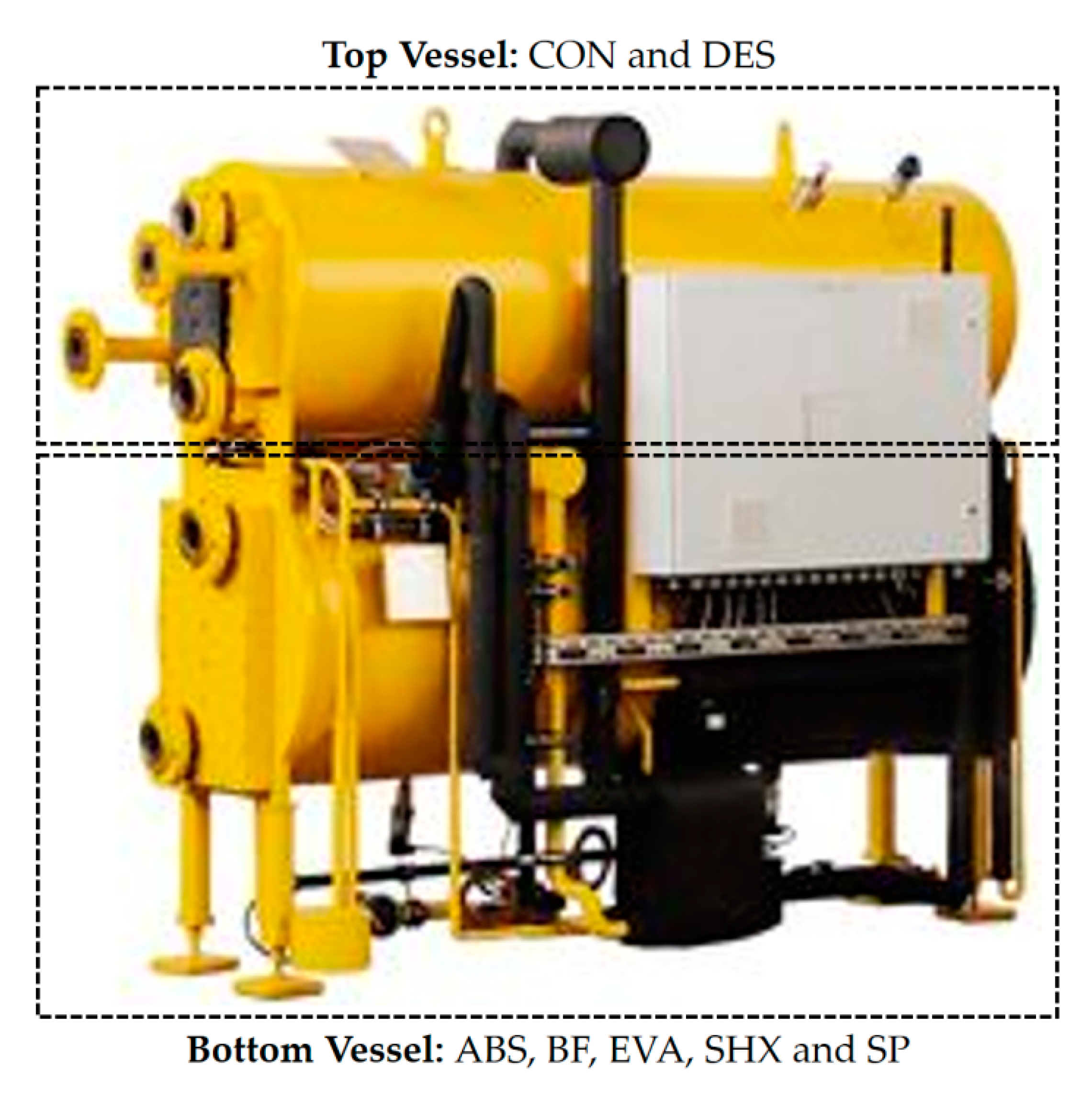
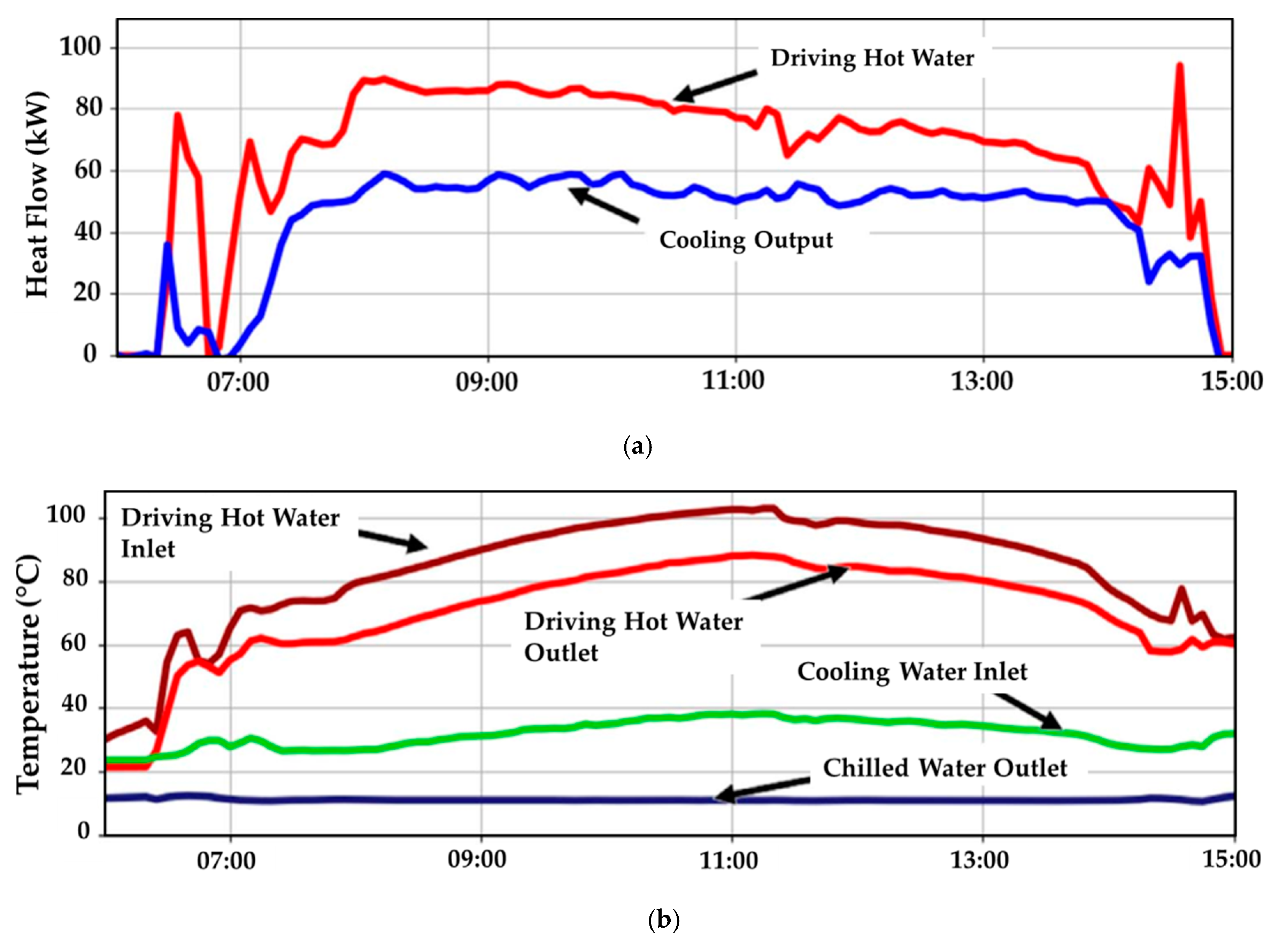
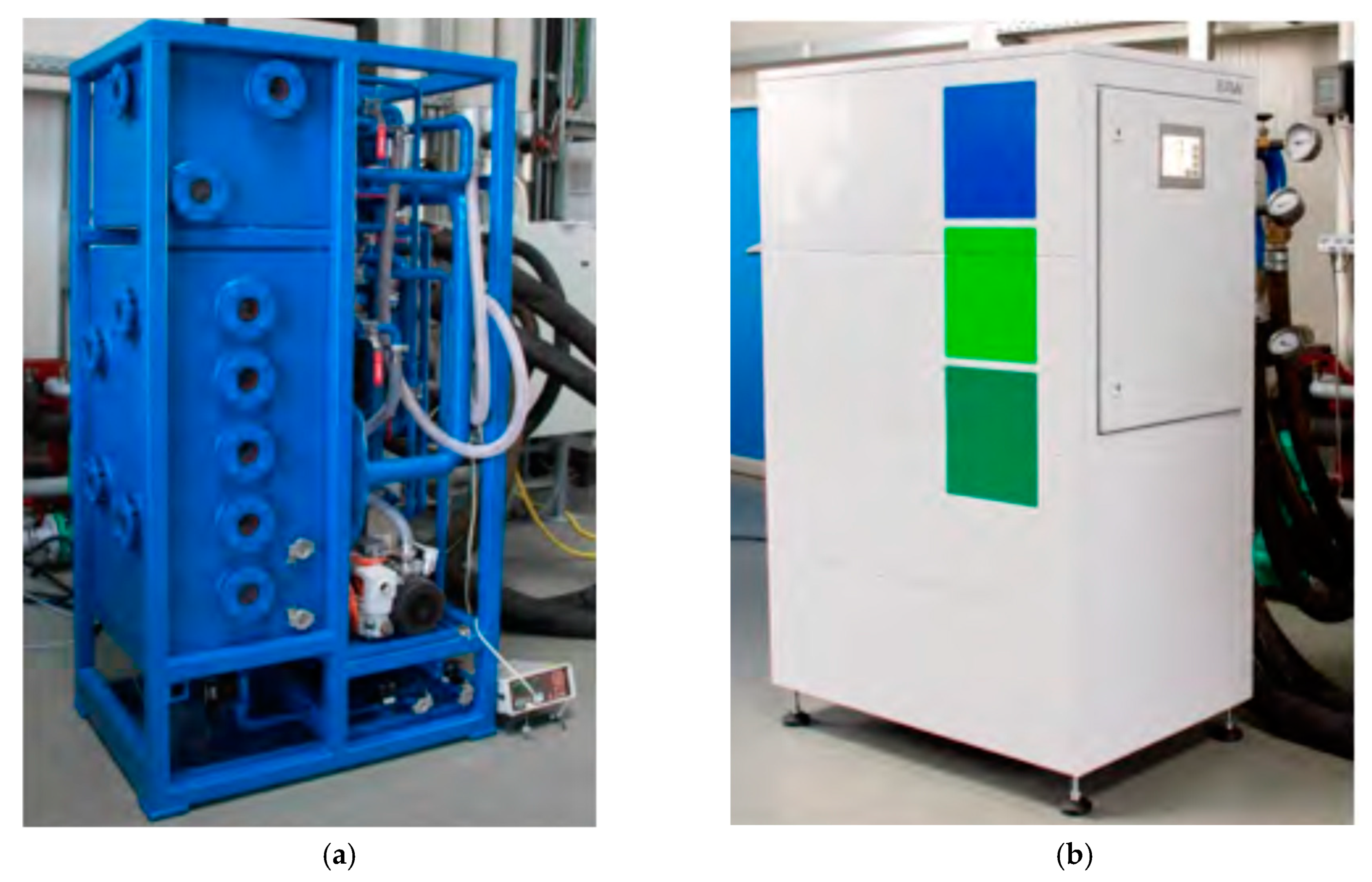
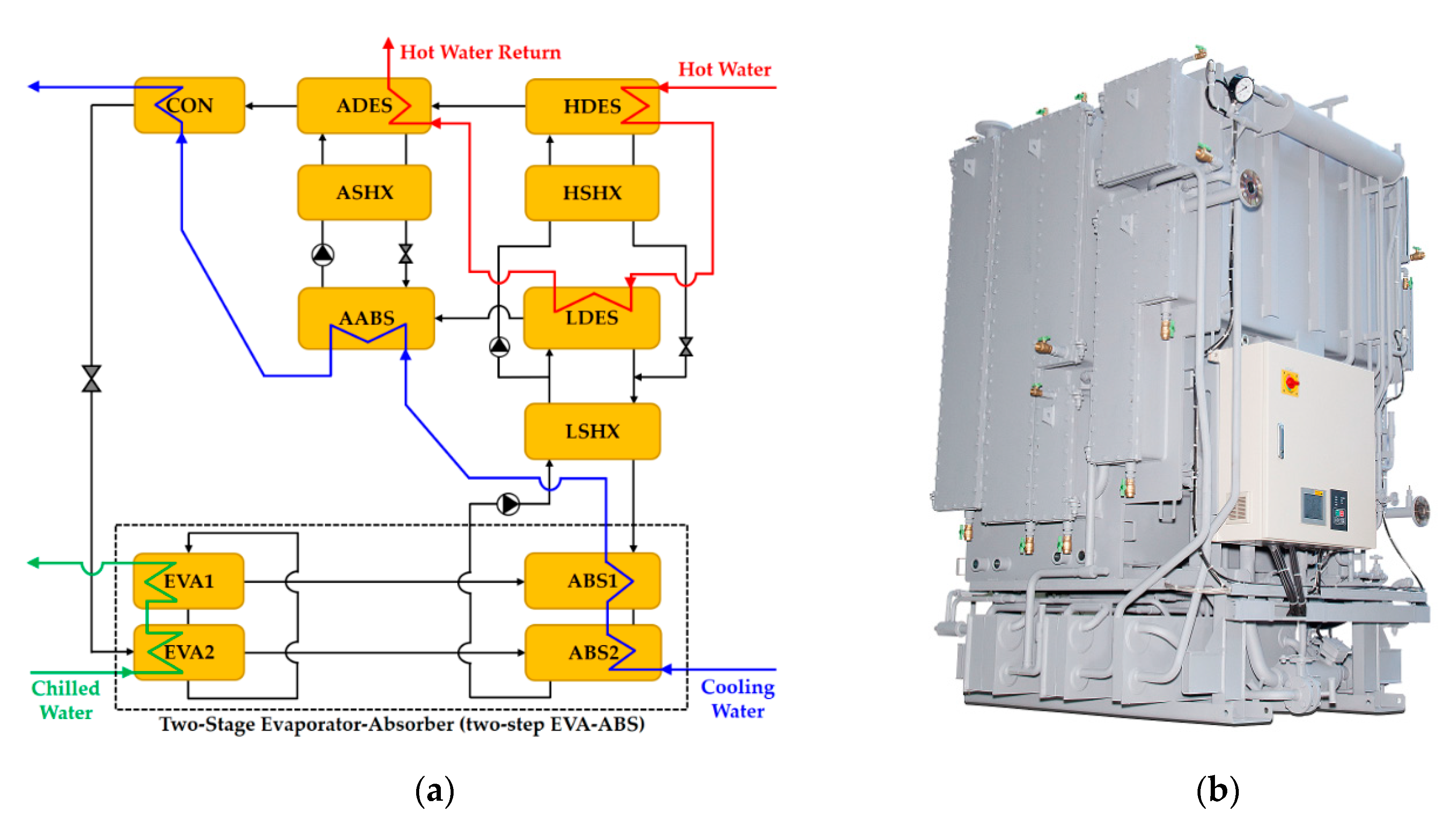
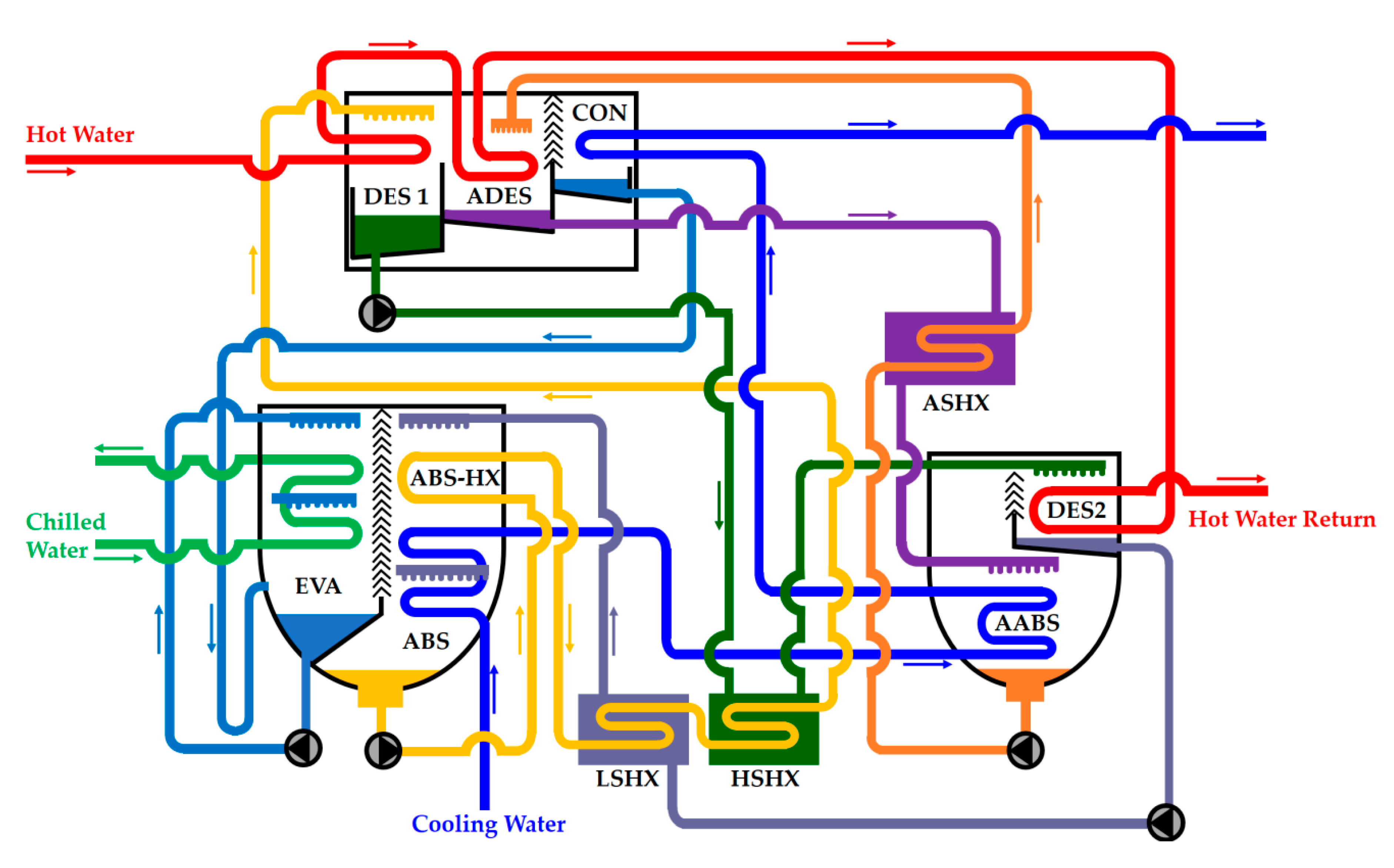


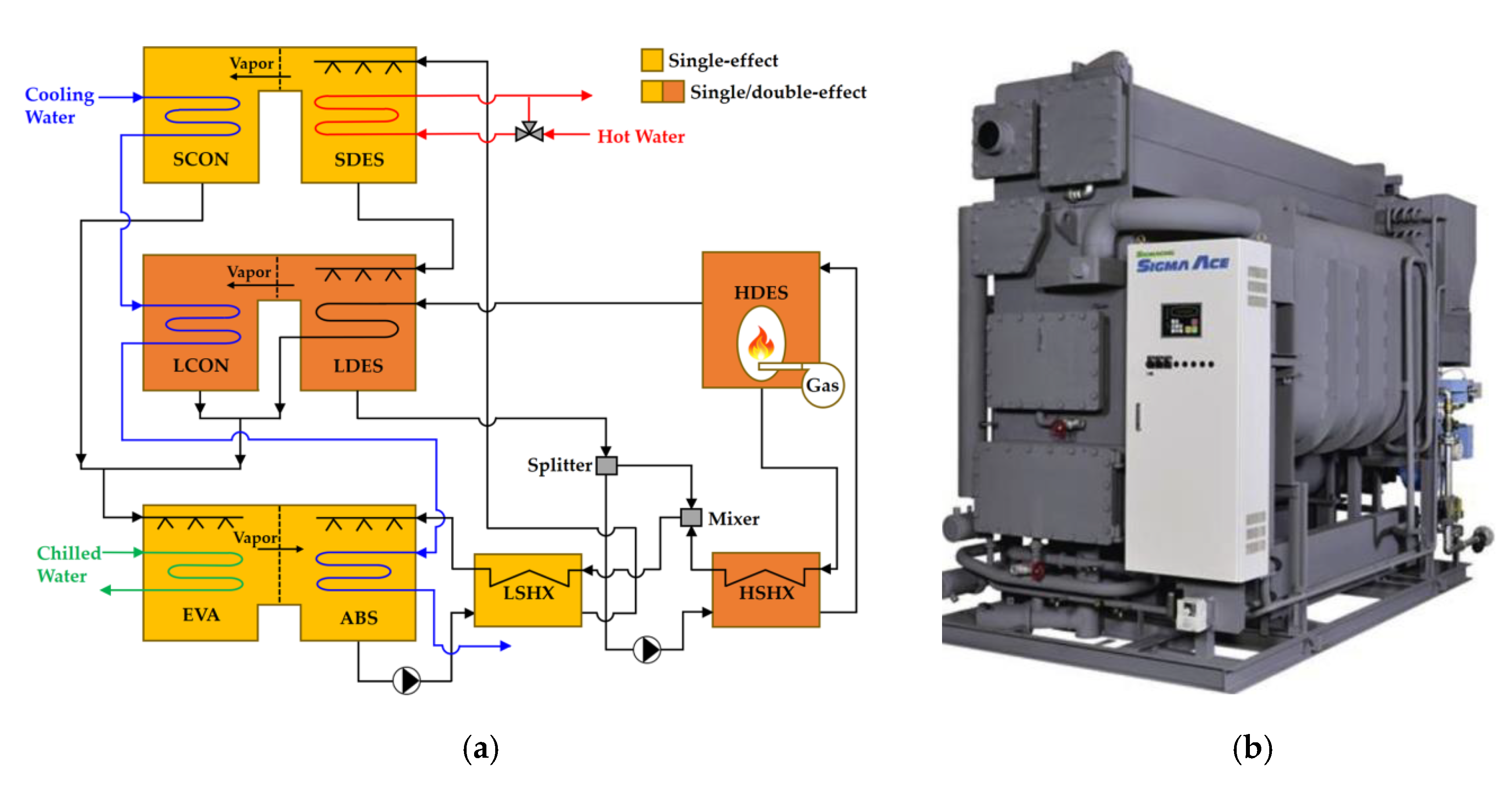
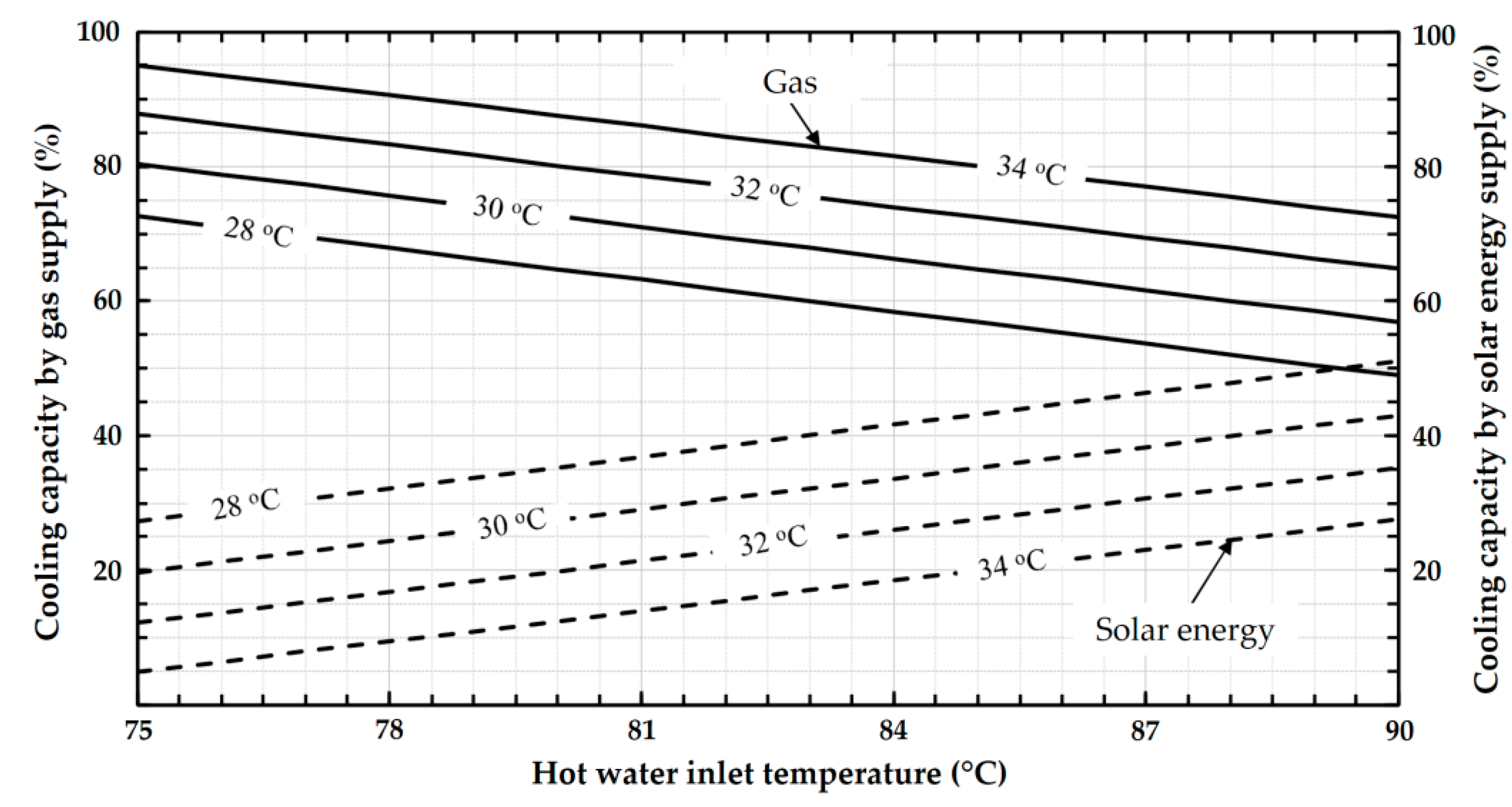
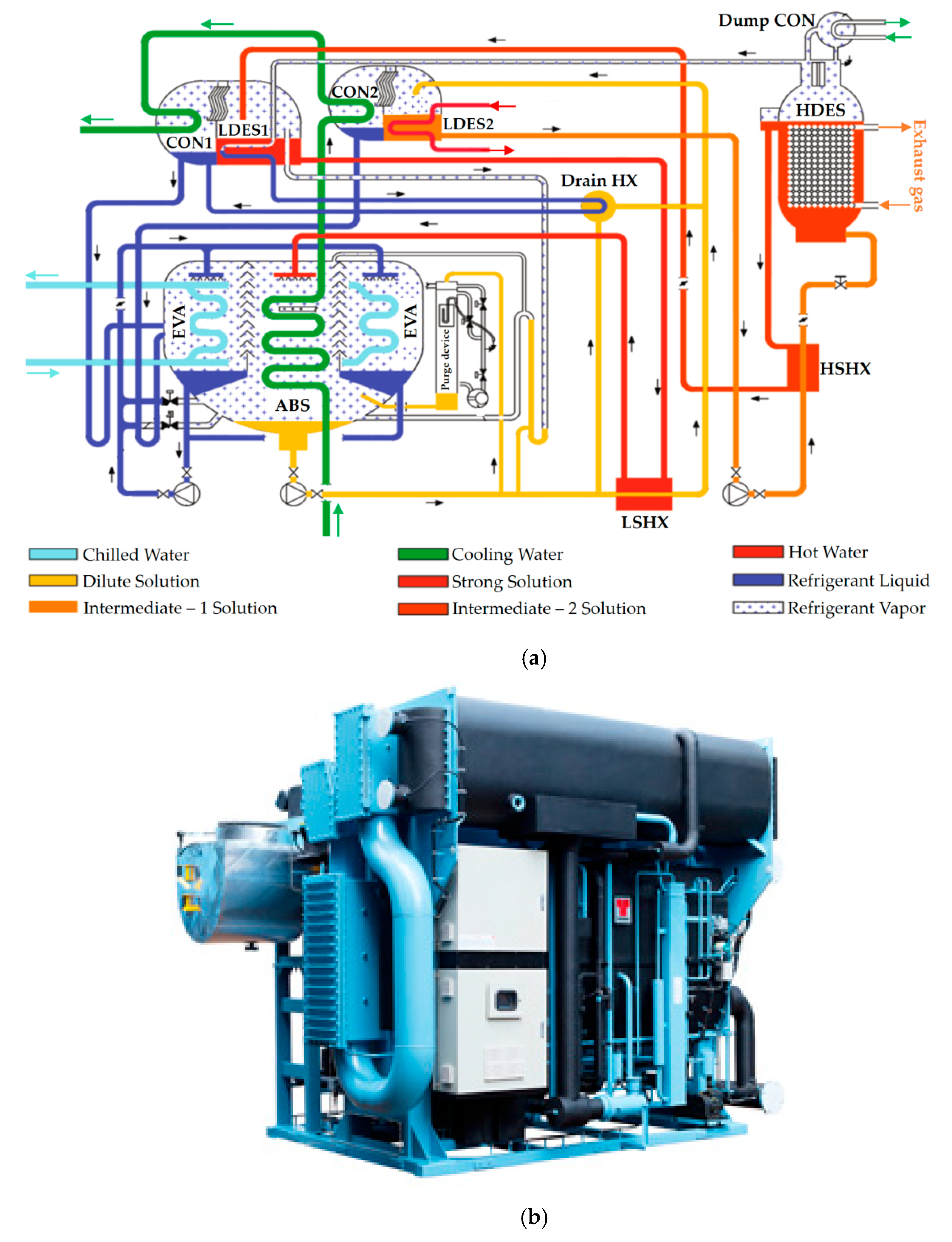

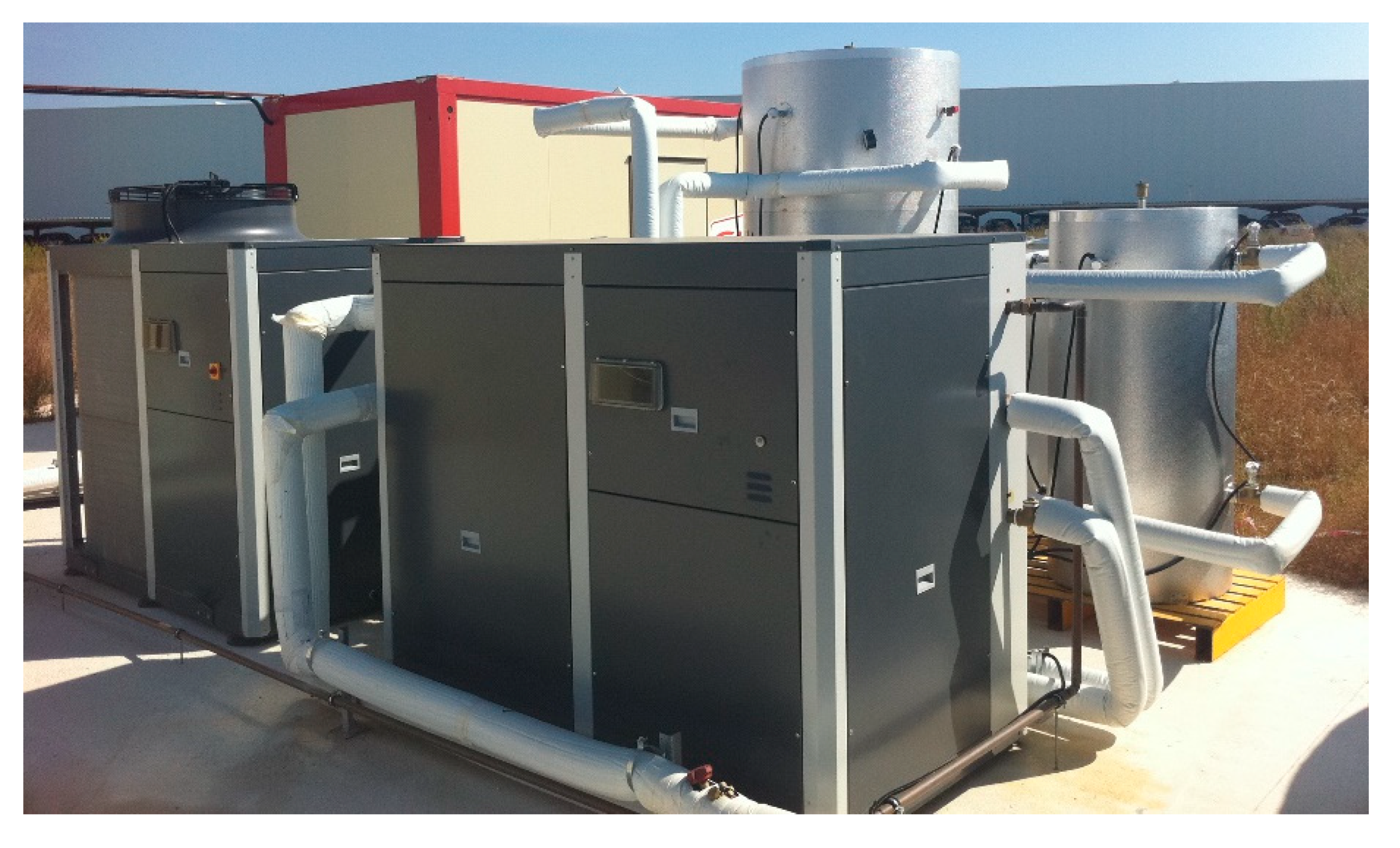
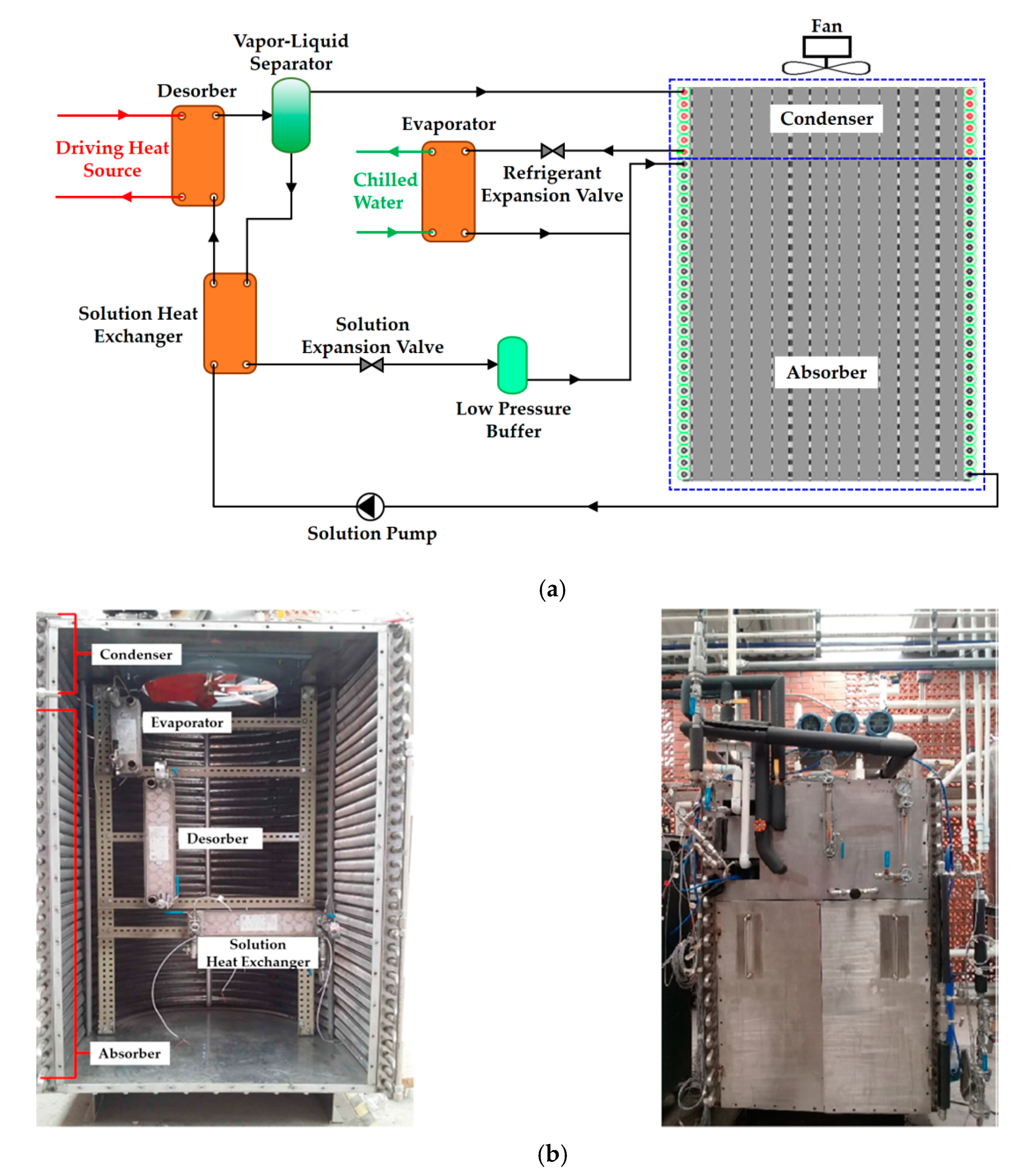

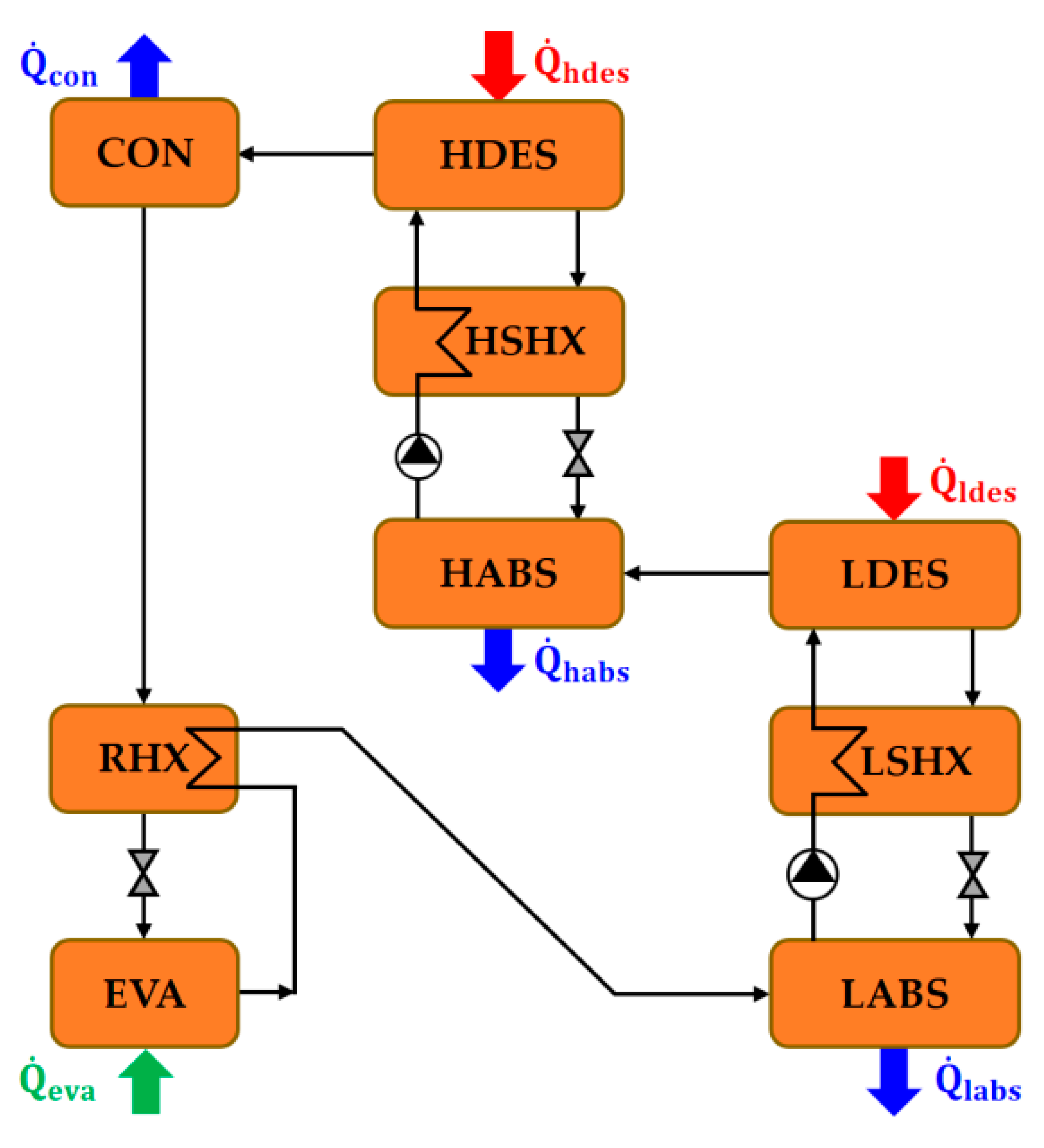
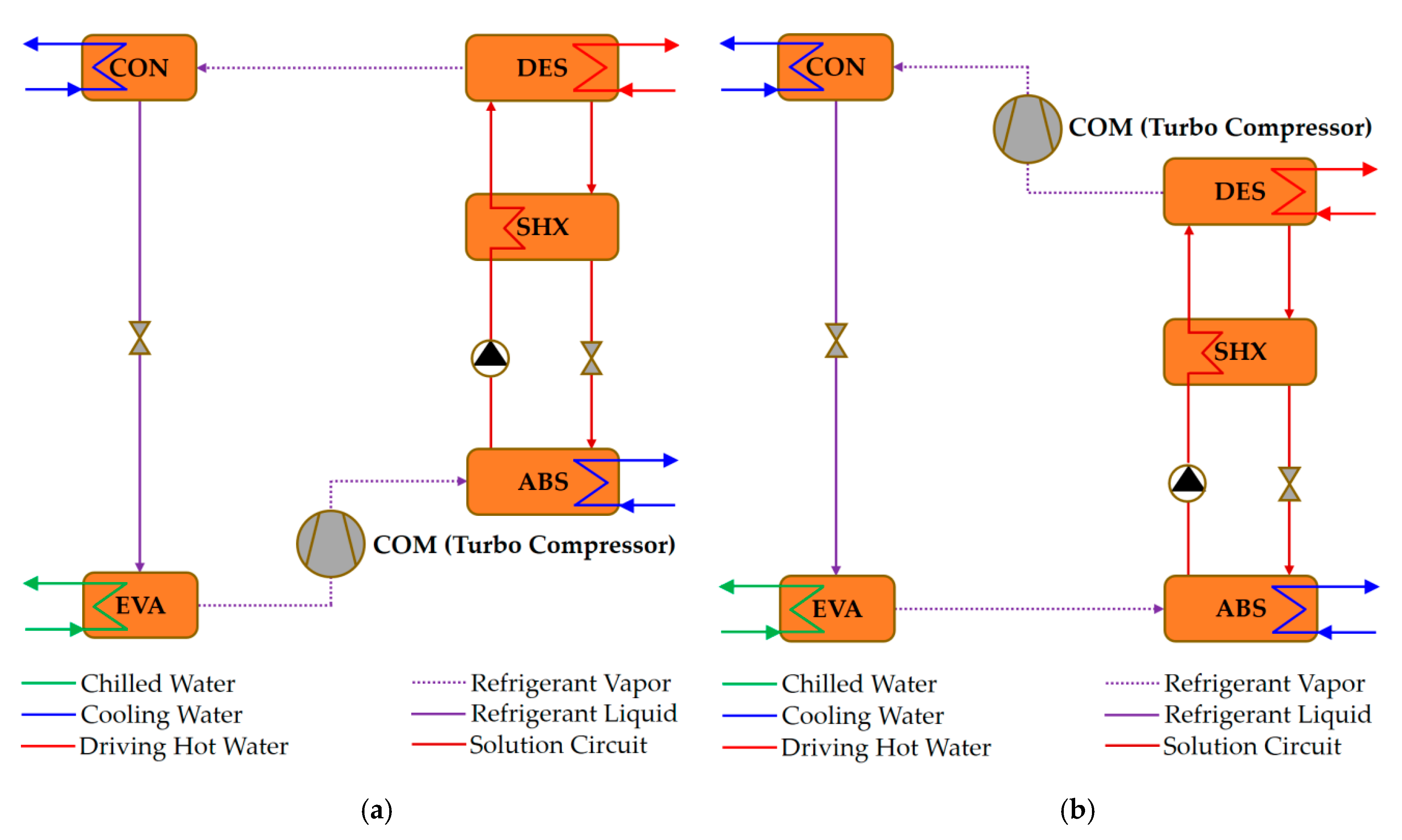
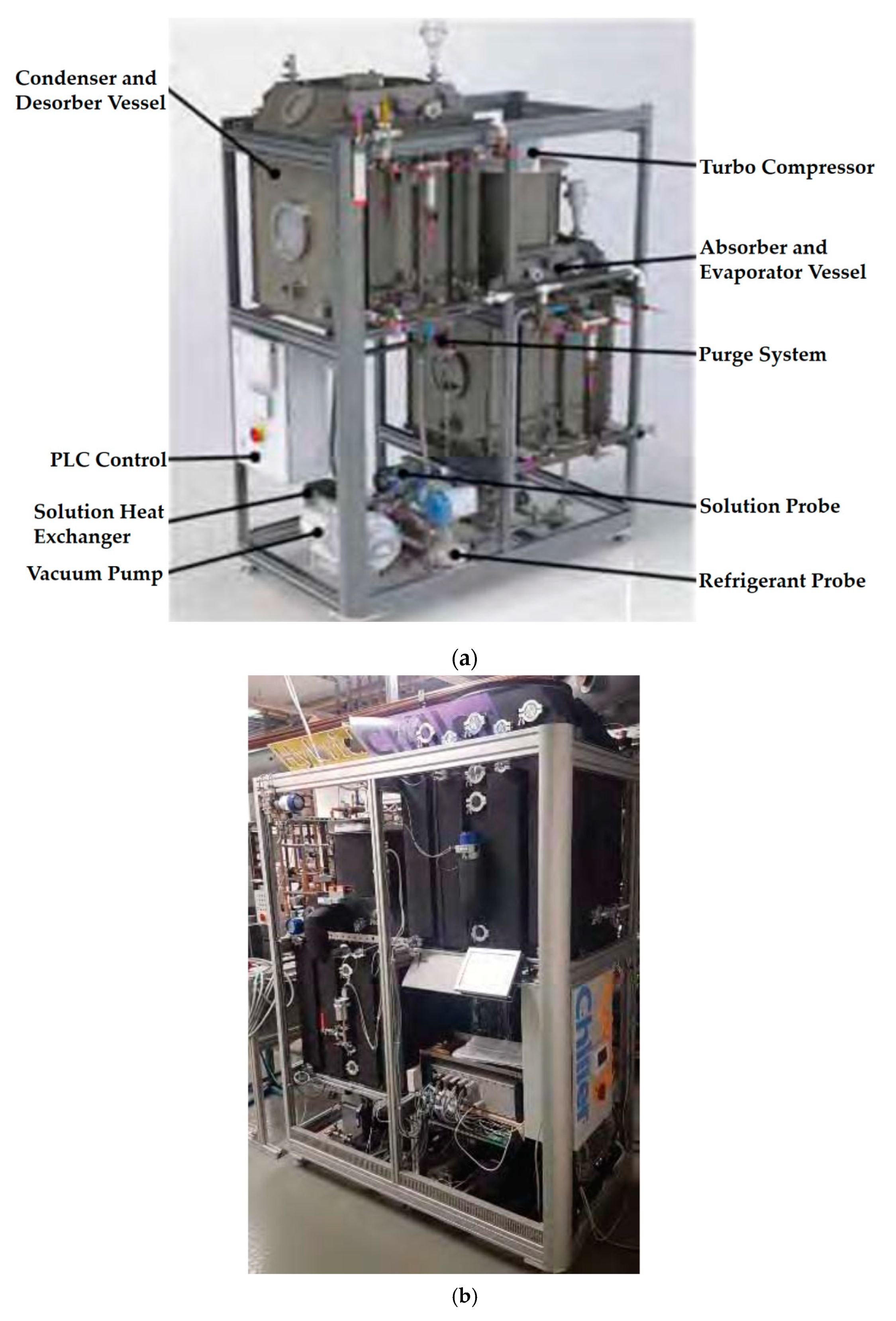
| Manufacturer (Country) | Technology | Capacity (kW) | Temperatures (°C) | (-) | Remarks |
|---|---|---|---|---|---|
| EAW Energieanlagenbau GmbH (Römhild, Germany) [32] | Cycle type: Single-effect Product: WEGRACAL® Maral 1; Maral 2; and Maral 3 | Maral 1: 15 Maral 2: 30 Maral 3: 65 | DHS inlet/outlet: 86/71 HR inlet/outlet: 27/32 CHW inlet/outlet: 15/9 | 0.75 | - DHS inlet temperature range: 75–95 °C - HR medium: water/ethylene glycol mixture (66/34%) or water - DHS temperature glide (K): 15 |
| Hitachi Johnson Controls Air Conditioning Co., Ltd., (Tokyo, Japan) [35] | Cycle type: Single-effect double-lift Product: DXS | 176–4395 a | DHS inlet/outlet: 95/51 b; 95/55 c HR inlet/outlet: 27/33 b; 31/36.5 c CHW inlet/outlet: 12/7 b; 13/8 c | 0.72 b; 0.70 c | - Half-effect (double-lift) or single-effect double-lift chiller operation - Two-stage structure for the absorber and evaporator (for high efficiency) - DHS temperature glide (K): 44 b; 40 c |
| Kawasaki Thermal Engineering Co. Ltd., (Tokyo, Japan) [37,43] | Cycle type: Single/double-effect Product: Model TZU80; TZU100; TZU120; TZU160; TZU180; TZU210; TZU250; TZU300 (eight product series) | 281–1055 a | DHS inlet/outlet: 90/79.5; 75/71.9 HR inlet/outlet: 32/37.6; 32/37.2 CHW inlet/outlet: 15/7 | ~1.1 | - Exclusively designed for solar cooling applications - Dual-heat sources: hot water from low-temperature solar collector at single-effect desorber and directly gas-fired double-effect desorber |
| PURIX ApS (Copenhagen, Denmark) [19,20,44] | Cycle type: Single-effect Product: Type A25 | 2.5 | DHS inlet: > 70 d Ambient: 35 e CHW inlet/outlet: 18/13 | 0.81 | - Directly air-cooled absorber and condenser - Complete set of solar air conditioner (A25s): outdoor unit (i.e., solar collectors and absorption chiller (ASC) and indoor unit (fan coils) |
| Thermax Ltd. (Pune, India) [42] | Cycle type: Single/double-effect driven by heat sources at two temperature levels Product: 2D Series (e.g., EJ Series) | 175–12,300 a | DHS inlet/outlet: N/R HR inlet/outlet: N/R CHW inlet/outlet: N/R | 1.1–1.2 | - High-grade: steam (~3.9–9.8 bar); exhaust gas (350–600 °C); hot water (150–180 °C) - Low-grade: hot water (80–95 °C) and steam (3.4 bar) - Minimum CHW supply temperature: up to 1 °C (water) and up to −2 °C (brine) |
| World Energy Co., Ltd. (Gunpo-si, South Korea) [36,45] | Cycle type: Single-effect double-lift Product: Models 2ABH and 2AB | 105–4571 a | DHS inlet/outlet: 95/55 HR inlet/outlet: 31/36.5 CHW inlet/outlet: 13/8 | 0.73 | - DHS temperature glide (K): 40 |
| W. Baelz & Sohn GmbH & Co. (Heilbronn, Germany) [26,28,46,47] | Cycle type: Single-effect Product: Baelz-absorpdynamic® Bee [26]; Bumblebee [27]; and Hornet [28] | Bee: 50 Bumblebee: 160 Hornet: 500 | DHS inlet/outlet: 90/72 HR inlet/outlet: 30/(37 or 38) [46] CHW inlet/outlet: 21/16 | ~0.8 | - Minimum DHS inlet temperature: 55 °C (“Bee”) and 60 °C (“Bumblebee” and “Hornet”) - Minimum CHW supply temperature: 5 °C - Quick response for cooling load changes: 25% to 100% in less than 10 min [47] - DHS temperature glide (K): 18 - Maximum HR temperature: 55 °C (“Bee”); 40 °C (“Bumblebee” and “Hornet”) |
| Organization, Project Partners (Country) | Technology | Working Fluid | Capacity (kW) | Temperature (°C) | (-) | Remarks | Authors (year), References |
|---|---|---|---|---|---|---|---|
| Munich University of Applied Sciences (Germany) | Cycle type: Compressor-boosted, single-effect Components: Falling film over side-by-side horizontal tube bundles HX for thermal components (ABS, CON, DES, and EVA) and R718 turbo compressor | H2O/LiBr | 15 | DHS: 90 (inlet) HR: 35–40 (CW inlet) CHW: 6 (outlet) | 0.753 * | - Laboratory prototype - turbo compressor: up to 3.5 pressure ratio; 90,000 rpm; and ~60% isentropic efficiency for <3.0 pressure ratio | Helm et al. (2019) [82] |
| Universidad Nacional Autónoma de México (Mexico) | Cycle type: Single-effect Components: (i) PHE with vertical orientation for the DES, EVA, and SHX; and (ii) serpentine finned stainless-steel tubes for the ABS and CON | NH3/LiNO3 | 0.8–3.4 | DHS: 80–100 (inlet) HR: 20–32 (CW inlet) CHW: <2.6 | 0.1–0.33 | - Laboratory prototype - Directly air-cooled chiller - Alfa Laval™ model Alfanova 52 for the DES and SHX using 40 and 20 plates, respectively. - Alfa Laval™ model Alfanova 27 using 20 plates for the EVA | Soto and Rivera (2019) [64] |
| Universidad Nacional Autónoma de México (Mexico) | Cycle type: Single-effect Components: (i) PHE with vertical configuration for the ABS, CON, DES, EVA, and SHX; and (ii) stainless-steel finned tube for the REC | NH3/H2O | 2.6 a | DHS: 85–105 (inlet)HR: 20–32 (CW inlet)CHW: 20 (inlet); N/R (outlet) | 0.61 a | - Laboratory prototype - −19 °C EVA temperature - Alfa Laval™ model Alfanova 52 used for the ABS, DES and SHX using 40 plates - Alfa Laval™ model Alfanova 27 used for the CON and EVA using 20 plates | Jiménez-García and Rivera (2019) [49] |
| University of Innsbruck, Graz University of Technology, Pink GmbH (Austria) | Cycle type: Single-effect and half-effect (double-lift) Components: PHE used for the ABS, CON, DES, and EVA | NH3/H2O | 18.4 b 10.6 c | DHS: 85 (inlet) HR: 20 b (inlet); 20–35 b; 20–45 c (inlet) CHW: 12/6 (inlet/outlet) | 0.57 b 0.27 c | - Laboratory prototype - Designed as a switchable system between single-effect and half-effect with a cooling capacity of 20 kW in single-effect | Neyer et al. (2018, 2017) [77,78] |
| Universidad Nacional Autónoma de México (México) | Cycle type: Single-effect Components: Stainless-steel PHE with vertical configuration for the ABS, CON, DES, EVA, and SHX | NH3/LiNO3 | 3.1 a 0.28–2.29 d | DHS: 80–95 (inlet) HR: 20–32 (inlet) CHW: 6 (outlet) | 0.62 a 0.032–0.23 d | - Laboratory prototype - Alfa Laval™ model Alfanova 52 used for the ABS, DES, and SHX using 40 plates - Alfa Laval™ model Alfanova 27 used for the CON and EVA using 20 plates | Jiménez-García and Rivera (2018) [61] |
| Politecnico di Milano (Italy) | Cycle type: Double-lift (half-effect) Components: Vertical shell-and-tube falling-film HX as the DES; tube-in-tube horizontal flow for the SHXs and the RCA; a shell-and-tube vertical flow countercurrent HX as the EVA; steel tube coils with vertical aluminum fins as the ABS and CON; and pall ring packed bed with solution cooled coil as the REC | NH3/H2O | 2.5 ** | DHS: 80–90 (inlet) CW: 22–38 (CW inlet) CHW: 12/7 | 0.3 ** | - Laboratory prototype - Air-cooled chiller - Electrical COP of 10 ** | Aprile et al. (2015); Guerra (2014) [75,76] |
| Universitat Rovira i Virgili, CIAT (Spain) | Cycle type: Single-effect Components: Brazed PHEs for all the thermal components (ABS, CON, DES, EVA, and SHX) | NH3/LiNO3 | 12.9 e 9.3 f | DHS: 90 (inlet) CW: 35 (CW inlet or ambient air) CHW: 15 (outlet) | N/R | - Two pre-industrial prototypes (indirectly air-cooled and water-cooled absorption chillers) - Nominal design parameters: cooling capacity of 10 kW; chilled water outlet of 1 °C; hot water and cooling water inlet of 90 °C and 37.5 °C, respectively - Electrical COP of 19.3 e and 6.5 f | Zamora et al. (2014) [57] |
| Universitat Politècnica de Catalunya, Termo Fluids S. L. (Spain) | Cycle type: Single-effect Components: falling-film heat exchangers with improved designs for heat and mass transfer. | H2O/LiBr | 7 | DHS: 88 (inlet) HR: 35 (air) CHW: 9 (outlet) | 0.7 | - A pre-industrial prototype - Directly air cooled absorption chiller | Oliva et al. (2014), Farnós et al. (2014) [69,84] |
© 2020 by the authors. Licensee MDPI, Basel, Switzerland. This article is an open access article distributed under the terms and conditions of the Creative Commons Attribution (CC BY) license (http://creativecommons.org/licenses/by/4.0/).
Share and Cite
Ayou, D.S.; Coronas, A. New Developments and Progress in Absorption Chillers for Solar Cooling Applications. Appl. Sci. 2020, 10, 4073. https://doi.org/10.3390/app10124073
Ayou DS, Coronas A. New Developments and Progress in Absorption Chillers for Solar Cooling Applications. Applied Sciences. 2020; 10(12):4073. https://doi.org/10.3390/app10124073
Chicago/Turabian StyleAyou, Dereje S., and Alberto Coronas. 2020. "New Developments and Progress in Absorption Chillers for Solar Cooling Applications" Applied Sciences 10, no. 12: 4073. https://doi.org/10.3390/app10124073
APA StyleAyou, D. S., & Coronas, A. (2020). New Developments and Progress in Absorption Chillers for Solar Cooling Applications. Applied Sciences, 10(12), 4073. https://doi.org/10.3390/app10124073






